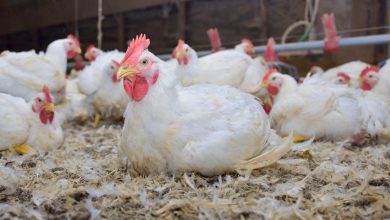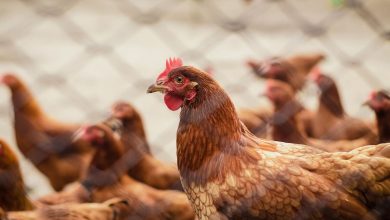Nutritional Interventions in Managing Gut Health of Chicken
Yasir Bashir Kemin Industries South Asia Pvt. Ltd.
Introduction
High growth rate and optimum feed efficiency are the two foremost objectives of the modern integrated broiler production. Factors responsible for deriving the optimum production and performance of bird are genetic potential, feed quality, nutrition, disease management, etc. In recent times, gut health management has gained a renewed importance in poultry production. Gut is an essential organ system which facilitates digestion of food to extract and absorb energy, and it is also a major site of potential exposure to environmental pathogens. Hence, a healthy gut is a core factor for deriving ideal performance of birds. When the gut health and function are hindered, the digestion and absorption of nutrients are affected thus impacting the performance of birds. Maintenance of gut development and its health are important to enhance the performance of chickens organism.
Gut health can be broadly defined as a dynamic equilibrium of complex interaction between diet quality, microflora population and intestinal mucosa, ensuring proper function of digestive system and lack of pathology. Consequently, maintaining overall health requires a healthy gut that is free from diseases such as dysbacteriosis, infections and inflammation. Healthy gut also provides a barrier between hostile lumen contents and internal tissues of the host. In this context, intestinal mucosa plays an important factor of gut health and performance of chicken. To support this protective function of gut mucosa, dynamic balance between epithelial cells, mucus layer, intestinal microbiota and immune cells in the gut is vital. A range of factors and infectious agents affect this dynamic balance in the gut, ultimately the health status and production of birds.
Extensive use of subtherapeutic dose of antibiotic and antibiotic growth promoters (AGP’s) has been used in poultry industry for decades to maintain the ecosystem balance in gut and the growth performance of chicken. However, due to increasing chances of antibiotic resistance in chicken, this practice has been questioned and hence, alternate to antibiotics is much needed in the poultry industry to enhance performance.
Commensal microbiota in the gut seem to have an important role in gut health and performance of chicken. It helps in directing the development of gut structure and morphology, modulate the immune responses, offer protection from luminal pathogens, aid digestion and utilization of nutrients. Some feed ingredients have been reported to modulate the gut microbiota and immune system which can be beneficial for birds are referred as nutraceuticals. Strategic use of nutraceutical compounds like enzymes, probiotics, prebiotics, organic acids and phytobiotics in poultry nutrition can result in positive influence on gut microbial ecosystem, immunity and performance of birds.
Enzymes
In a typical corn soya diet of broilers there is a substantial amount of anti-nutritional factors called non-starch polysaccharides (NSP’s) like β-glucans, xylans, arabinoxylans, pentosans, pectins and mannans that can negatively affect the normal digestion and absorption of nutrients in gut. This shows the ability of NSP’s to increase the digesta viscosity and prevent the optimum enzyme activity in the gut lumen. The increased viscosity due to soluble NSP’s reduces physical contact between the endogenous enzymes and nutrients acting as a barrier that decreases movement of enzymes and substrate molecules. Also, soluble NSP’s change the physiology and ecosystem of gut which is mainly related to slower digesta rate. A slow moving digesta with low oxygen tension in small intestine could provide a stable environment where fermentative microflora can establish.
It was documented that the increased dietary soluble NSP leads to the onset of necrotic enteritis (NE) in poultry. In this context, the exogenous enzymes like arbinoxylanases, beta glucanases and mannanases are used to correct the lack of specific endogenous enzymes for digesting certain nutrients in feedstuffs or to hydrolyse the anti-nutritional factors in feed ingredients. Supplementation of non-conventional ingredients (containing anti-nutritional factors and fibre) in poultry diet reduce the feed cost and encourage the use of exogenous enzymes, as they cannot be digested fully and utilized by chickens. Consequently, increased intestinal viscosity due to high-fiber diets depress feed passage rate and increase pathogenic microbial population in small intestine. Dietary incorporation of exogenous enzymes to degrade these NSP’s leads to the reduction of gut viscosity, better digestion and diffusion of nutrients through the gut wall. In addition to NSP’s, presence of undigested protein in the gut can also impact gut health by reducing protein fermentation in large intestine. Most of the bacterial population present in the hindgut is able to ferment undigested protein resulting in toxicity, tissue damage and inflammatory response directly or as a result of the harmful metabolites produced by protein fermentation such as indoles, biogenic amines, branched chain fatty acids, and ammonia. Therefore, reducing the supply of undigested protein by enhancing the protein digestibility is an important factor in maintaining optimal gut health in poultry birds. A holistic approach involves the use of multi enzyme combinations like NSPases and protease to effectively combat the negative effects of the anti-nutritional factors which will result in improved gut health and performance.
Probiotics
Direct fed microbials, called as probiotics are single or mixed culture of live microorganisms which when administrated in adequate numbers exert health benefits for the host by improving the host intestinal microbial balance, enhancing colonization resistance against pathogens and improving the immune responses. The main probiotics used in poultry nutrition includes Lactobacillus spp., Bifidobacterium spp. and Bacillus spp. These probiotic preparations act by maintaining a healthy balance of bacteria in the gut by competitive exclusion through which they exclude potential pathogenic bacteria by competing for attachment site in the intestine. This is performed by the process of antagonism, whereby, the antagonistic activity towards pathogens can be attributed to the production of bactericidal substances including bacteriocins and organic acids. Bacteriocins are active proteinaceous substances produced by variety of gram-negative and gram-positive bacteria that have bactericidal action. The bactericidal action results in the production of organic acids like lactic acid associated with pH reduction in intestinal tract and inhibiting the growth of exogenous pathogens. Dietary incorporation of probiotics promotes gut maturation and integrity. Alteration of bacterial population in the gut by probiotics also refers to the production of digestive enzymes, reduction in bacterial enzymes and suppression of ammonia production.
Prebiotics
Prebiotics are classified as feed ingredients that benefits the host gut health by stimulating the growth and activity of beneficial bacteria present in the gut. To improve the host microbial balance, prebiotics provides energy for the growth of endogenous favorable bacteria in the gut, such as Bifidobacteria and Lactobacilli. Nutritionally, addition of prebiotics benefits the overall gut health and compliment the effect of probiotics which favor the growth of commensal bacteria that already adapted to the gastrointestinal tract (GIT). The mechanism by which prebiotics exert the beneficial effects is due to the increase in number of lactic acid bacteria in gut that may aid competitive exclusion of pathogens from GIT of birds. The increased production of short chain fatty acids (SCFA’s) with prebiotics, resulting in increased intestinal acidity may also contribute to the suppression of pathogens in the chicken gut. Prebiotics have been reported to enhance the immune response of chicken, resulting in rapid clearance of pathogens from the gut. This may be due to direct interaction between prebiotics and gut immune cells, and indirect action of prebiotics via preferential colonization of beneficial microbes and microbial products that interact with the immune cells. The most common prebiotics used in poultry are oligosaccharides including inulin, fructo-oligosaccharides (FOS), mannan-oligosaccharides (MOS), galacto-oligosaccharides (GOS), soyaoligosaccharides (SOS), xylo-oligosaccharides (XOS), pyrodextrins, isomalto-oligosaccharides (IMO) and lactulose.
Organic Acids
A renewed focus is laid upon the use of organic acids like lactic, acetic, tannic, fumaric, propionic and caprylic acids in poultry feed to maintain optimum gut health, improve nutrient utilization and growth performance. They have been used for more than 50 years to reduce bacterial growth and mold in feedstuffs, thus preserving the hygienic quality of feed. Apart from improving feed hygiene, many studies demonstrated that organic acids stabilize the gut microfloral balance and also have an effect on feed digestion and absorption. These weak acids are added to feed in sub-therapeutical dosage and believed to have the capacity to improve growth performance, nutrient utilization and health.
Postulated mode of action of organic acids is directly related to the ability to reduce intestinal pH, followed by alterations in intestinal ecosystem. Supplementing organic acids lowers the intestinal pH, control microbial growth and colonization, and lowers the nutrient competition. Apart from the positive effect on growth performance and nutrient digestibility, organic acid has favorable impact on gut histomorphology. It has been reported that dietary incorporation of organic acids increases the villus width and height, area of duodenum, jejunum and ileum of broiler chicks. Organic acids lead to decreased thickness of muscularis in all the segments of small intestine. This helps in improving the digestion and absorption of nutrients, since the thickening of mucous layer on intestinal mucosa contributes to reduce digestive efficiency and nutrient absorption. In addition, organic acids have beneficial effect on gut microbial population. Sub-therapeutic doses of organic acids modulate the natural microbial population in the gut by decreasing the adhesion of bacteria such as: Escherichia coli, Campylobacter, Clostridium perfringens, Salmonella kedougou and Salmonella gallinarum.
Phytobiotics
Phytobiotics are plant derived bioactive compounds, mostly secondary metabolites of plants and can be categorized as: phenolics and polyphenols (phenolic acids, quinones, flavones, tannins, and coumarins), terpenoids and essential oils, alkaloids, lectins and polypeptides. Phytobiotics are classified based on the biological origin and c hemical description into 4 groups as: 1. Herbs – derived from flowering, non-woody and non-persistent plants 2. Botanicals – entire or processed parts of a plant like root, leaves and bark 3. Essential oils – hydro distilled extracts of volatile plant compounds 4. Oleoresins – extracts based on non-aqueous solvents The exact mode of action by which phytobiotics provide benefits on the gut remains unclear. But the possible mechanism may be due to modulating the cellular membrane of microbes leading to the membrane disruption of pathogens, increasing the hydrophobicity of microbial species that influence the surface characteristics of microbial cells and thereby affecting the virulence properties of microbes. Another way is by stimulating the growth of favorable bacteria such as Lactobacilli and Bifidobacteria in the gut, and by protecting the intestinal tissue from microbial attack. Phytobiotics stimulate the proliferation and growth of absorptive cells in GIT which results in greater villus height and deeper crypt and, influence the production and/or activity of digestive enzymes like increasing the activities of amylase and protease, thus improving the growth performance of birds. Positive effect of phytobiotics on gut health and growth performance may differ based on the composition of biological factors (plant species, growing location and harvest conditions), manufacturing process (extraction/ distillation, stabilization) and storage conditions like temperature, oxygen tension and time.
Conclusion
Gut health and development are affected by various complex interactions between diet, microbial colonization and intestinal mucosal integrity. Optimum gut health may affect the way feed nutrients are partitioned and utilized for organ development, tissue growth and immune functions. Consequently, healthy gut assumes a pivotal role for successful production system in poultry. Traditional use of AGP’s to maintain the gut health is not a complete and holistic approach, owing to their resistance and problems associated with residues in meat and eggs. Therefore, strategic nutritional use of nutraceutical compounds have been used to improve the gut ecosystem of birds, growth promotion and to prevent the enteric infections in poultry.




Hi, the Nutritional Interventions in Managing Gut Health
of Chicken article it is well written and has helped me a lot.
Let me share with you a product that helped my mother lose
62 lbs of raw fat: http://bit.ly/lose-1lb-of-fat-every-72-hours
Be beautiful! Be happy! 🙂 Kiss you All!
Hi, the Nutritional Interventions in Managing Gut
Health of Chicken article it is well written and has helped me a lot.
Let me share with you a product that helped my mother lose 62 lbs of raw fat: http://bit.ly/lose-1lb-of-fat-every-72-hours
Be beautiful! Be happy! 🙂 Kiss you All!